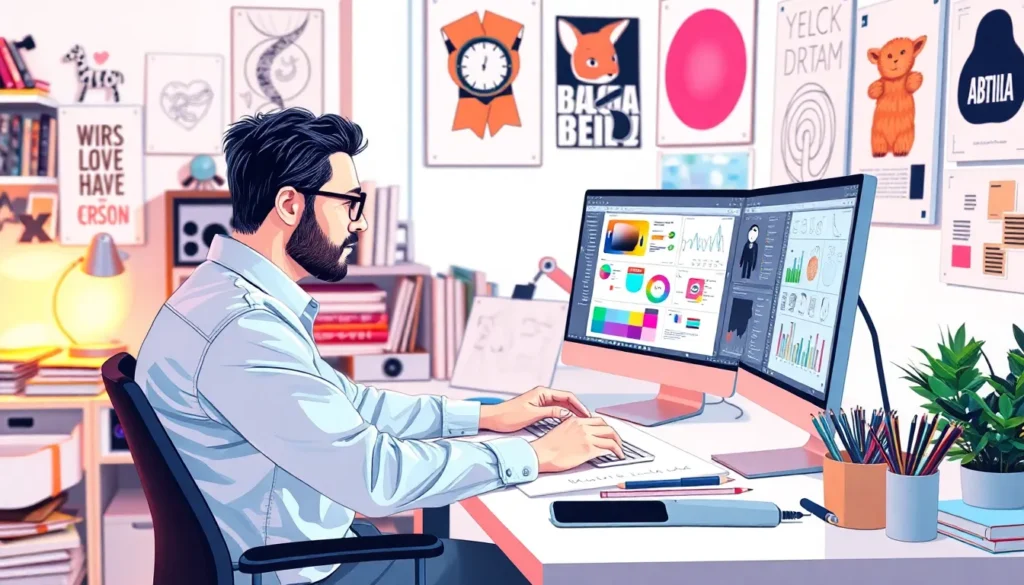Table of Contents
ToggleIn a world where first impressions matter more than ever, graphic design can make or break your message. Whether you’re crafting a killer social media post or designing a sleek website, the right visuals can grab attention faster than a cat video on the internet. But don’t worry—graphic design doesn’t have to be rocket science.
With a few clever tips and tricks up your sleeve, anyone can transform their designs from “meh” to “wow.” From choosing the perfect color palette to mastering typography, these insights will help elevate any project. So grab your favorite design tool and get ready to unleash your inner Picasso—because who said creativity can’t be fun?
Essential Graphic Design Tips
Color selection plays a crucial role in graphic design. Choose a color palette that reflects the brand’s identity. Use complementary colors to create visual harmony and enhance readability.
Typography acts as the backbone of any design project. Select fonts that align with the message being conveyed. For digital platforms, prioritize legibility and scalability of font size.
Layouts contribute significantly to the overall design. Ensure a balanced layout by organizing elements strategically. Maintain adequate white space to prevent visual clutter.
Images enhance the visual appeal of a design. Utilize high-quality images that support the content and evoke emotion. Always credit image sources or choose royalty-free options to avoid copyright issues.
Consistency throughout the design reinforces brand recognition. Apply the same color scheme, typography, and overall style across all materials. Create templates for social media posts and brochures to streamline future designs.
Feedback helps refine design skills. Seek constructive criticism from peers or design communities. Regularly reviewing designs encourages continuous improvement and fosters creativity.
Experimentation facilitates unique designs. Don’t hesitate to try different styles or layouts. A willingness to explore various design techniques can lead to innovative results.
Understanding Your Audience

Knowing your audience enhances the effectiveness of graphic design. Insight into user preferences and behaviors shapes decisions and leads to stronger visual communication.
Researching User Preferences
Identifying user preferences involves analyzing trends and feedback. Engaging with surveys and direct interaction provides invaluable data. Utilizing tools such as Google Analytics highlights user behaviors, revealing which visuals resonate most. Tracking social media engagement offers insights into popular styles and colors. Collecting this data enables designers to create relevant and appealing graphics.
Creating User Personas
Developing user personas establishes a clear depiction of target audiences. Each persona serves as a fictional representation, including demographics, interests, and behaviors. Crafting detailed profiles helps in visualizing users during the design process. Designers benefit from understanding pain points and motivations unique to each persona. Tailoring graphics based on persona insights ensures alignment with user expectations, improving overall engagement.
The Importance of Color Theory
Color theory plays a crucial role in graphic design. It influences emotions and perceptions, guiding effective visual communication.
Choosing a Color Palette
Selecting a color palette involves understanding brand identity. Designers often utilize tools like Adobe Color to create harmonious combinations. Primary colors garner attention while secondary colors provide balance. Neutral colors serve as backdrops to highlight important elements. Using three to five colors helps maintain consistency and simplicity without overwhelming the viewer. Brands often thrive by aligning their color choices with their target audience’s preferences.
Color Psychology in Design
Color psychology significantly impacts how designs are perceived. Red evokes excitement, while blue instills trust and calmness. Yellow often represents optimism, promoting positive sentiments. Green suggests growth and health, making it popular for eco-friendly brands. Understanding these associations allows designers to convey specific messages through color choice. Each color offers unique emotional responses, reinforcing brand narratives effectively. Incorporating these insights enhances user experience and engagement, creating a lasting impression.
Typography Best Practices
Typography plays a crucial role in graphic design. Well-chosen fonts enhance readability and support brand identity.
Selecting the Right Fonts
Choosing the right fonts is fundamental for effective design. Designers often look for legible and versatile typefaces. Sans-serif fonts work well for digital platforms, while serif fonts provide a classic feel. Pairing fonts adds visual interest; for instance, combining a bold header with a clean body font creates a balance. Limiting font choices to two or three maintains consistency across designs. Checking licensing rights for commercial use remains essential, as using unauthorized fonts can lead to legal issues.
Hierarchy and Readability
Establishing hierarchy improves readability. Designers create focal points through font size, weight, and color contrast. Larger headings naturally attract attention. A clear distinction between headings and body text guides readers smoothly through content. Using adequate line spacing avoids visual clutter, enhancing text clarity. Aligning text consistently, whether left-aligned or centered, improves the overall layout. Testing designs across various devices ensures readability remains intact, catering to diverse audiences effectively.
Designing for Different Mediums
Designing for various mediums requires specific approaches to maximize impact. Each medium presents unique characteristics that influence design choices.
Print Design Tips
Print design demands attention to detail in color choices and typography. Designers must ensure colors translate well from screen to paper, often utilizing Pantone colors for consistency. High resolution images are essential; at least 300 DPI guarantees clarity. Selecting appropriate paper types affects both aesthetics and tactile experiences, enhancing the overall impression. Designers also focus on layout, ensuring adequate margins and balanced compositions. Lastly, proofing designs before final prints helps catch potential issues, preventing costly mistakes.
Digital Design Considerations
Digital design prioritizes adaptability across devices and screen sizes. Designers utilize responsive layouts that adjust seamlessly, ensuring an optimal user experience. Fast-loading images play a critical role, with compression techniques improving performance without sacrificing quality. Color contrasts must enhance readability, especially on diverse backgrounds. Interactive elements should be intuitive, guiding users through content effectively. Testing designs on various browsers and devices ensures functionality remains consistent, while incorporating user feedback fosters continuous improvement.
Mastering graphic design is a journey that combines creativity with strategic thinking. By applying the tips shared in this article, anyone can elevate their design skills and create impactful visuals. It’s essential to remain open to experimentation and feedback as these elements foster growth and innovation.
Understanding the audience and utilizing color theory and typography effectively can lead to designs that resonate deeply. Whether designing for print or digital platforms, attention to detail will always pay off. With practice and dedication, anyone can transform their ideas into compelling graphics that leave a lasting impression.


